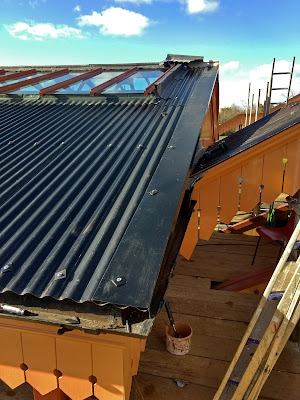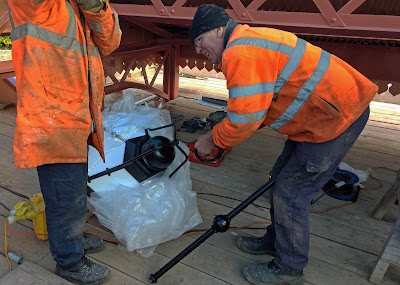Thursday and Friday on the canopy.
There are only a small handful of days left to finish the canopy. We thought we had a week to spare, but little things came along, the flashings were delayed and in the end we are working every day until the scaffolding comes down. That is due to take place on Monday next week.
 |
| The long awaited flashing arrives. |
The flashing was late because - well, there are lots of excuses these days, on both sides of the table. Finally we had a message from the supplier that 4 x 3m lengths were ready for us - last Wednesday. Too late for delivery before the scaffolding comes down, so all that we could do was volunteer someone (ahem...) to drive 220 miles to go and get the stuff. It would have been very awkward to attach the flashing to the end of the canopy, with the scaffolding removed.
Among the several small jobs remaining was the fabrication of a frame to which the WAY OUT sign could be attached.
Here is John cutting some angle to size for that frame. We spent quite a few minutes debating where exactly the sign would be hung - by the exit, obviously - but because the footbridge and the canopy are not in the place where they ought to be (see previous blogs) the location of the big hexagonal lamp, the last truss and the WAY OUT sign are not exactly where they were in 1904.
We stared intently at the 1904 opening picture, of which we have a blow up in the mess room. We consult that a lot! We finally decided that it would be next to the hexagonal lamp, even if that had shifted position a few feet. The GENTLEMEN sign (at the other end of the building in 1904) also interferes with the sighting line if we put the WAY OUT exactly where it was originally.
Neal started the day with the final length of architrave, here along the Malvern side. Of course it has a purpose, but it's sculpted lines do make the station design attractive as well.
Nailing it on means another round of painting for yours truly, as the nail heads need something over them, otherwise they will rust and spoil the paintwork.
Later in the day the bracket for the WAY OUT sign was made up, and test fitted with a G clamp. It will hang from this frame on two pieces of steel to just below the dagger board height.
Having nailed on the architraves on the Malvern side, Neal started on the flashing pieces. They are 3m long each, but that is still way too short for one side of the roof, so two are being cut to fit end to end.
Later in the day the Cotswolds side flashing was seen to be up. This makes a neat end to the building, and also gives a bit of protection against rainwater seeping in from the end. The lead flashing at the top has been removed to make this possible, so looks a bit untidy. Neal will put it back on, don't worry.
So how many working days do we have left then? Er, one, was the conclusion. Better get on with mounting the big lantern then.
The two big lanterns (yes, two, as the other is for the P2 side in the same place there) have been in storage, and one was taken out for fitting.
How to get it up to the 'conservatory' at the top under the glazing?
We felt that the safest way for it (one was already damaged before it even reached us, and has since been repaired free of charge by the supplier) was to carry it across the tracks to the other platform, then walk it up the steps, over the footbridge, and then half way back down again and into our 'conservatory'.
Here it is upstairs now, while Neal prepares the job by threading through the wiring.
Then came the tricky job of hanging it from the ridge purlin. Three scaffolding boards were removed temporarily, to allow the nose of the lamp to poke through underneath.
To drop this would have been catastrophic - it took us 5 years (!) to organise these unique replica lanterns. We can think of only one similar set in existence - at Moor Street station, Birmingham.
A certain episode of 'Only Fools and Horses' was constantly on our minds....
The 'gas supply' pipe had to be attached to the lantern, then wound carefully into the threaded holes in the ridge purlin above, by revolving the whole thing round and round, hoping that the thread would finally bite, and not cross thread itself. We got there! There is a lock nut on top as well.
A last look of the lantern in place.
On Monday the scaffolders will come and take the scaffolding down again. We hope and pray they don't put a pole through the glass. Carefully does it, Lads!
Tamping the PWay winter works
The PWay winter works - rail replacement and dipped joint removal at Dixton, replacement of turnouts at Cheltenham, Toddington north, Toddington South and the Toddington yard throat - have been completed as far as the rails and sleepers are concerned, but cannot be signed off until they have been ballasted and tamped.
Here the tamper is at Hayles Abbey halt, where a fault in the computer occurred, which meant a return to Toddington and a new part required for it.
 |
| Approaching Toddington, from inside the leading cab. |
A snag has also arisen in that the Winchcombe slip works are still not finished, despite being ahead of schedule at one point. Principally this involves removing the ballast and membrane placed over the track, and all the S&T reinstatement afterwards.
Because of that the tamper and ballast supply trains cannot reach CRC, or the Dixton cutting. Extra tamper time will therefore have to be organised, unfortunately at extra cost.














Baited breath on Monday, yes? That lantern top does look uncomfortably close to everything. I sincerely hope that the scaffolders are a careful bunch of lads😬
ReplyDeleteThat said, everything looks fantastic, and from the webcam, the building now looks huge, compared to the 1904 photo.
It is certainly bigger, maybe 50% bigger, due to the requirement for lots of extra toilets, all at the staircase end. Sadly the builder decided it would have fewer chimneys than the original, despite the extra length - 2, instead of 3.
DeleteIt is rumoured that two chimneys is because he thought that Toddington had two chimneys. But of course Toddington had three, with one currently knocked down back to roof level.
Another heritage idea is to rebuild the missing Toddington one - the base is still visible.
Looking good, Jo! It will be great to see it without the scaffolding after next Monday! Does the cable for the lamp run inside the "gas pipe"? It looks like its running outside in the photos.
ReplyDeleteThe cabling is all inside, you won't see it. It now just needs powering up from the building.
DeleteHi Jo, will a gate be attached to the footbridge steps to prevent access to the public?
ReplyDeleteThere will be a barrier. The steps are not actually quite finished, the canopy took over as it had to be done in a certain period.
DeleteStill to do:
- Finish the boarding on the Malvern side
- Fit handrails
- Cover the treads with an abrasive material
Of course it's the footbridge to nowhere at the moment - we'd like to offer our services to do the P2 building. I think we have earned our spurs with the canopy, as a monument to what we can do, on time, on budget.
Thanks Jo. It looks fantastic
DeleteHear, hear.
DeleteNeal,Jo and team have done a brilliant job , when any Railway awards are dished out they should be up there.
ReplyDeleteHear , Hear , Hope you choose the best category to win an HR award , richly deserved and make sure you get an article in the magazines asap , more good publicity to start our season well . john M .
ReplyDeleteI too reiterate what has been said above. The lamp looks wonderful and I too hope the scaffolders are careful when at work on Monday!?!
ReplyDeleteRegards, Paul
Full of admiration for your planning, methods used and problem solving. Your skills and shear hard graft should get you some sort of permanent recognition. Very many thanks for the pictures and notes which have helped us follow your progress.
ReplyDeleteRon
Great blog as usual Jo. Hope scaffold removal goes OK.
ReplyDeleteIf scaffolding is to be used on a freeway or highway, the contractor is required to have a license especially for this and is responsible for applying for and obtaining such a license. https://superiorscaffoldingauckland.co.nz/
ReplyDelete